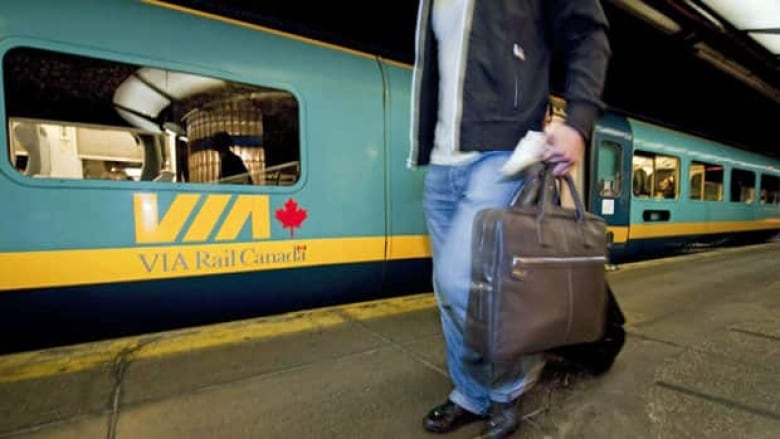Via Rail trying to limit scope of policy allowing couples with mobility devices to travel together
'It's not enough in this day and age,' says couple who had been fighting for more accessibility

Via Rail is trying to limit the scope of a policy to make its trains more accessible to travellers using wheelchairs and mobility aids.
The national rail provider had revised its policy in May in compliance with an order from the Canadian Transportation Agency, which directed Via to double the number of mobility devices that could be tied down on trains from one to two.
The ruling was prompted by a complaint to the CTA from a married couple who asserted the old rules barred them from travelling together.
- Via Rail changes policy on wheelchairs, mobility aids on trains
- Federal court dismisses VIA Rail appeal on couples with mobility scooters travelling together
- VIA Rail appealing ruling that would allow couples with mobility scooters to travel together
Via's revised policy was subject to approval from the CTA, which wrote the company in June to confirm that the new rules would be applied to "all Via trains operating across Canada."
Couple 'disappointed'
But Via Rail has now explicitly stated it only plans to implement the revised policy for travel between Quebec City and Windsor, Ont.
It also says it can currently only apply the policy on one of the three classes of train travelling that route, leaving the couple whose complaint sparked the change concerned that Via has no genuine commitment to broader accessibility.
Marie Murphy and Martin Anderson, who both use mobility scooters due to their cerebral palsy, said Via's position makes them feel as though they're back at square one.
They criticized Via for focusing solely on their specific situation rather than working to make trains more accessible for
wheelchair travellers nationwide.
"I'm somewhat disappointed that it's 2017 and a federal crown corporation still feels that one (tie-down) spot is enough," Anderson said."It's not enough in this day and age."
Via Rail declined to comment on a "pending legal matter," while the CTA said it would not weigh in while it was still reviewing Via's latest submissions.
Railway changed policy in May
Previously, trains featured only one tie-down area for someone travelling in a wheelchair or mobility scooter, and other passengers using such devices were forced to dismantle the aids and store them in the luggage compartment, risking damage to the equipment.
After the CTA ruled in favour of Murphy and Anderson, Via changed its policy in May, saying it would make it possible for two mobility aids to use the existing tie-down area on trains as long as the users had the capacity to transfer to a regular seat for the trip.
If a user who could not transfer to a regular seat wanted to book the tie-down spot, the policy contained a clause allowing them to bump another mobility aid user from the area even if they'd previously reserved it.
On June 23, the CTA sent Via a letter seeking "confirmation" of several points, including the fact that the new accessibility rules would be applied on every Via train across the country.
No plans to implement policy nationally
Via Rail's July 12 response, filed after a deadline set by the CTA, made it clear that a national implementation was not planned.
"The policy will be implemented on the Quebec City-Windsor corridor only," the letter states.
"This corridor formed the object of the original complaint, it is where the applicants travel and where the train configurations discussed in the proceedings since the beginning are in effect.
Nothing in the application, the evidence nor in responses of either party referred to the operation or configuration of trains outside this corridor and the applicants made no mention of travel outside the corridor in their application."
Via's revised policy in May, however, contained no language restricting the rules to a specific route.
A letter accompanying the policy at the time stated the company would take 60 days to train Quebec-Windsor Corridor staff on the new rules before they would be "fully implemented and applied."
Anderson and Murphy, who have travelled successfully along the Quebec-Windsor route since May, said they would go further afield if they were assured they could receive adequate accommodations.
But Via's latest position has them questioning even their ability to travel within the specified route, since the company has spelled out restrictions on the types of trains that can accommodate two mobility aids at once.
Railway argues only certain cars can comply
Via's July 12 letter lays out the three classes of car that service the Quebec-Windsor Corridor — LRC, Renaissance and Hep2.
At the moment, it contends only LRC cars can safely comply with its new rules.
It said it's in the process of refurbishing its Hep2 cars to allow for more mobility aids but did not give a timeline for
completion, and added Renaissance cars can't be made more accessible without "undue hardship."
Murphy and Anderson filed a response to the CTA on July 21 decrying Via's pushbacks and seeking $15,000 in compensation for their legal costs.
Via responded to the CTA, calling the couple's claims "out of order, illegal, inaccurate and unfair." It also requested
permission to address their concerns in more detail by Aug. 4.
The CTA has not made a decision on that request.